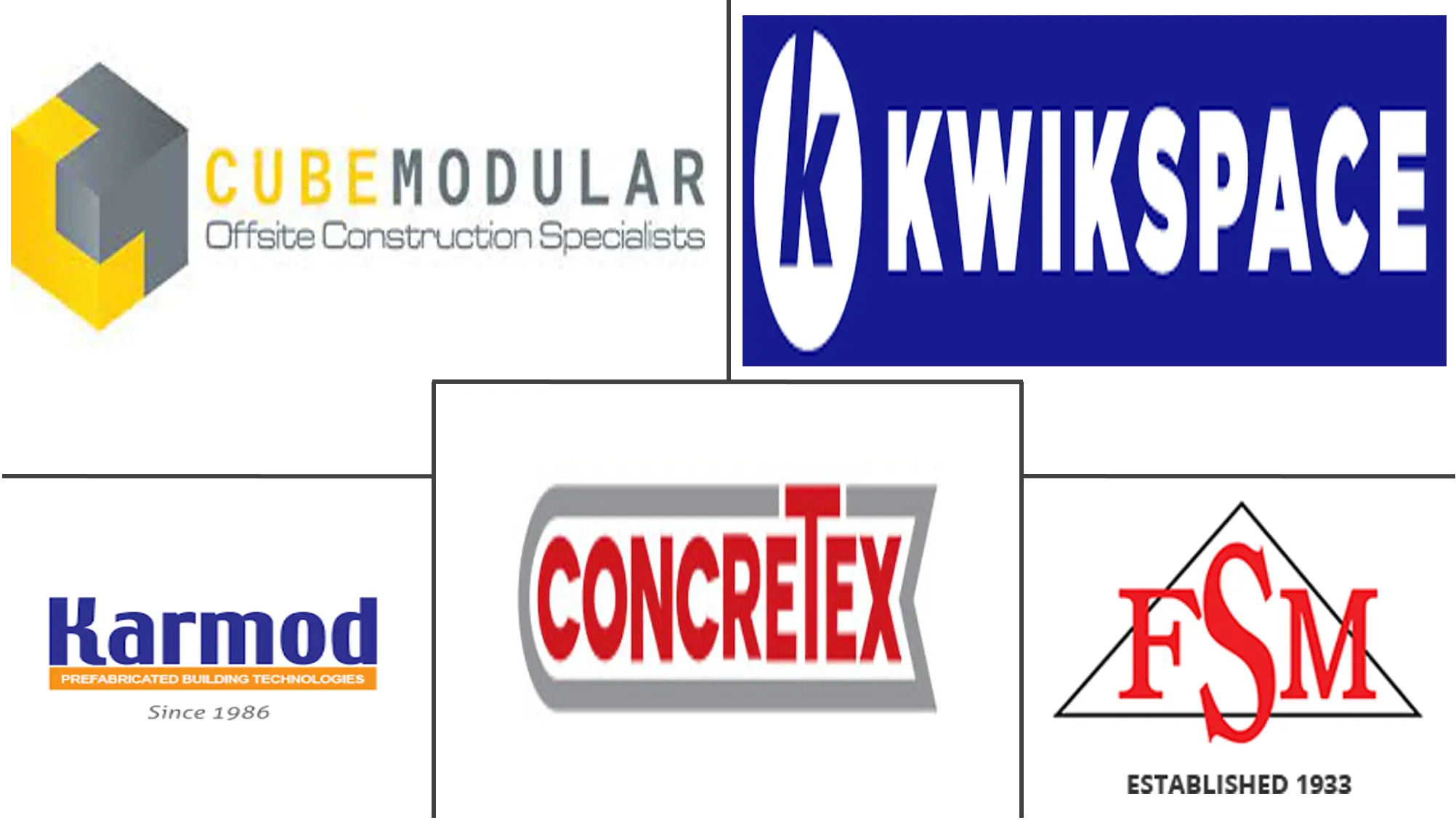
| Study Period | 2019 - 2029 |
| Base Year For Estimation | 2023 |
| Forecast Data Period | 2024 - 2029 |
| Historical Data Period | 2019 - 2022 |
| CAGR | 5.50 % |
| Market Concentration | Low |
Major Players
*Disclaimer: Major Players sorted in no particular order |
Africa Prefabricated House Market Analysis
The size of the Africa prefabricated housing market is USD 4.8 billion in the current year and is anticipated to register a CAGR of over 5.5% during the forecast period. The market was negatively impacted by COVID-19 in 2020. The growth was impacted due to the economic downturn caused by the COVID-19 pandemic across the residential, commercial, industrial, and institutional sectors in Africa.
- Prefabricated housing created affordable housing solutions and many employment opportunities for the residents. Due to the lack of the ability to provide housing on time in terms of human resources and materials, serious housing shortages exist across Africa.
- The lack of end-user financing and affordability makes the situation more difficult. The government and developers are constantly striving to find solutions to make it possible for middle-income people to buy their own houses. Developers are seeing rapid urbanization as an opportunity.
- In 2021, the GDP of the Nigerian real estate industry recorded positive growth, a 2.3% increase from NGN 3.96 trillion (USD 8.6 billion) recorded in the previous year. Despite the activities witnessed in 2021, the housing deficit in Nigeria remains at about 22 million. The market is yet to see the expected home demand and supply volume.
- Nigeria's housing inventory is dire, with a chronic shortage of affordable and available homes needed to support the nation's population. According to Oxford Business Group, by 2050, Africa's population will double, meaning that the region will include added 3.5 million people per month. Africa will contribute more than half of the world's total population growth by then and more than three-quarters of that growth up to 2100.
Africa Prefabricated House Industry Segmentation
Prefabricated homes, often called prefab homes, are primarily manufactured in advance off-site, then delivered and assembled on-site. The report covers a complete assessment of the Africa Prefabricated Housing Market. It includes an assessment of the economy market overview, market size estimation for key segments, and emerging trends in the market segments. The report sheds light on the market trends like growth factors, restraints, and opportunities in this sector. The competitive landscape of the Africa Prefabricated Housing Market is depicted through the profiles of active key players. The report also covers the impact of COVID-19 on the market and future projections.
The Africa Prefabricated Housing Market is segmented by type (single-family and multi-family) and country (Nigeria, Egypt, South Africa, and the Rest of Africa). The report offers market sizes and forecasts in value (USD) for all the above segments.
| Single Family |
| Multi Family |
| Nigeria |
| Egypt |
| South Africa |
| Rest of Africa |
Africa Prefabricated Housing Market Size Summary
The prefabricated housing market in Africa is poised for significant growth, driven by the urgent need for affordable housing solutions and the rapid urbanization across the continent. Despite the challenges posed by the COVID-19 pandemic, which temporarily hindered market expansion, the sector is expected to recover and expand steadily. The market's growth is supported by the increasing demand for cost-effective and efficient construction methods, such as prefabricated and modular housing, which are gaining traction as viable alternatives to traditional building practices. This shift is particularly evident in countries like Egypt and South Africa, where government initiatives and private sector collaborations are aimed at addressing the housing deficit and making homeownership more accessible to middle-income populations.
The African prefabricated housing market is characterized by a diverse range of players, both international and domestic, who are leveraging advanced production technologies to enhance efficiency and reduce costs. However, the market remains fragmented, with high capital requirements and rapid technological advancements posing challenges for new entrants. Key market participants, including Karmod Prefabricated Building Technologies and Kwikspace Modular Buildings Ltd., are focusing on innovative solutions such as turnkey projects and lightweight ceramic houses to meet the growing demand. As urban populations continue to rise, particularly in countries like Nigeria and Ethiopia, the market is expected to see increased investments in prefabricated housing projects, further driving its expansion during the forecast period.
Africa Prefabricated Housing Market Size - Table of Contents
1. MARKET DYNAMICS
- 1.1 Drivers
- 1.2 Restraints
- 1.3 Opportunities
-
1.4 Industry Attractiveness - Porter's Five Forces Analysis
- 1.4.1 Bargaining Power of Suppliers
- 1.4.2 Bargaining Power of Consumers / Buyers
- 1.4.3 Threat of New Entrants
- 1.4.4 Threat of Substitute Products
- 1.4.5 Intensity of Competitive Rivalry
2. MARKET SEGMENTATION
-
2.1 By Type
- 2.1.1 Single Family
- 2.1.2 Multi Family
-
2.2 By Country
- 2.2.1 Nigeria
- 2.2.2 Egypt
- 2.2.3 South Africa
- 2.2.4 Rest of Africa
Africa Prefabricated House Market Research FAQs
What is the current Africa Prefabricated Housing Market size?
The Africa Prefabricated Housing Market is projected to register a CAGR of greater than 5.5% during the forecast period (2025-2030)
Who are the key players in Africa Prefabricated Housing Market?
Karmod Prefabricated Building Technologies, Kwikspace Modular Buildings Ltd., Cube Modular, Fabricated Steel Manufacturing and Concretex are the major companies operating in the Africa Prefabricated Housing Market.


